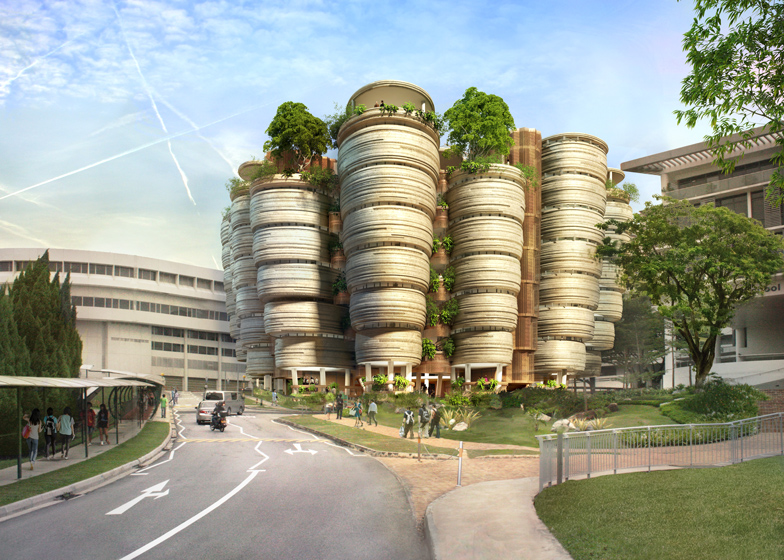UK designer Thomas Heatherwick has released images of a technology education building under construction at Nanyang Technology University in Singapore.
Resembling a cluster of elongated bee hives, the Learning Hub at Nanyang Technology University explores new ways of teaching at a time when computers and the internet are challenging the rationale of learning institutions.
"Before, the university was the place you would come to because it had the computers, or the university was the place that you would come to because it had the books," said Heatherwick, explaining the concept of the building in a keynote speech at World Architecture Festival in Singapore last year. "And now, you can just stay in your bedroom with your [iPhone] and get your PhD and deal with the different professors - and so what is the purpose of a university building anymore?"
In response, the university wanted to dissolve the traditional relationship between the tutor and the student, to encourage a new kind of collaborative studying. "They no longer want the model of a master at the front of the class," said Heatherwick in his lecture. "[That] is something that they want to move away from completely."
The building consists of several 8-storey towers containing stacks of tutorial rooms, but avoids using traditional circulation and room layouts. The rooms are corner-less, to dissolve the standard classroom hierarchy where the tutor is at the front and the students all face towards him or her.
Instead of corridors, each level features open galleries where students can circulate and meet. And instead of a conventional entrance, the building is porous at ground level, meaning people can approach and enter from any direction.
"So the building has no one door, it's all porous," said Heatherwick. "You can just walk into one big shared space that links the whole thing together."
Nanyang Technology University was masterplanned by Japanese architect Kenzo Tange in the 1980s and features buildings set in lush gardens. Heatherwick's design reflects this by placing plants and trees on the roof and on some of the circulation levels.
Images are courtesy of Heatherwick Studio. Here's more information from the studio:
Heatherwick studio has won a competition to design a Learning Hub for a university in Singapore. The hub will be part of a £360 million scheme which Nanyang Technological University is undertaking, and is the first redevelopment of its campus’ in twenty years.
It was clear to us that since the advent of the internet and low cost computers that there has been a distinct shift in how students approach educational facilities. University buildings have ceased to be the only site where students are able to source educational texts, and have become unappealing spaces with endless corridors, no natural daylight and only hints of other people’s presence.
The studio’s approach was to redefine the aspiration of a university building, and to once again make it an essential part of the tertiary education experience. Within this new context the purpose of a university is to foster togetherness and sociability, so that students can meet their fellow entrepreneurs, scientists or colleagues in a space that encourages collaboration.
The hub’s form is dictated by its function, and brings together 55 tutorial rooms into a structure without conventional corridors, which have traditionally created social separation and isolation. The learning hub has no one door, it is porous. Students can enter from 360 degrees around into a large central space which links all the separate towers together. Each tower is made up of a stack of classrooms which build up gradually, with gardens on selected floors.
Another inspiration for the hub was a wish to break down the traditional square forward-facing classrooms with a clear front and hierarchy, and move to a corner-less space, where teachers and students mix on a more equal basis.
In this model, students work together around shared tables, with teacher as facilitator and partner in the voyage of learning, rather than ‘master’ executing a top-down model of pedagogy.
Each of these tutorial rooms faces the large shared central space, allowing students to continually feel connected to all the other activities going on in the building.
In 2013 the learning hub was awarded the BCA Green Mark Platinum Award for sustainability by the Singaporean government. The award is a benchmarking scheme which incorporates internationally recognised best practices in environmental design and performance.

